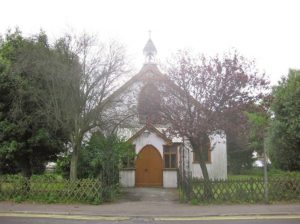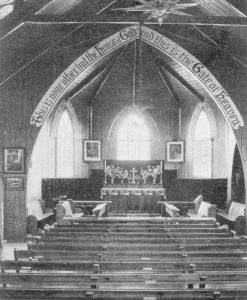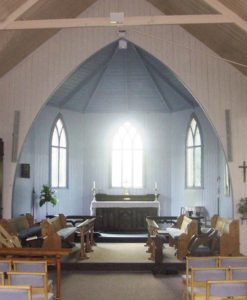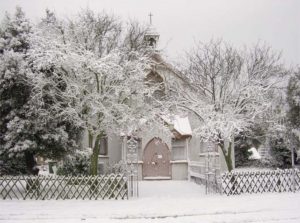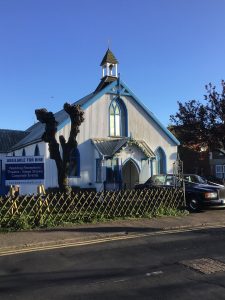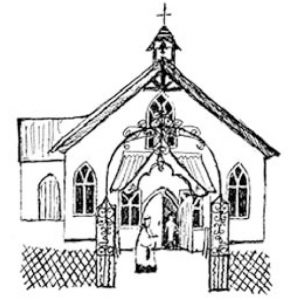History
St Michael and All Angels, The Tin Tabernacle, Hythe, Kent
Whereas the Parish Church of St Leonard’s occupies the most prominent position in the town, St Michael’s Church was situated in the most convenient and accessible.
Erected on a triangular site at the junction of Stade Street and Portland Road and adjacent to the Town Bridge, it cannot escape the notice of the passer-by. Lovingly referred to as the ‘tin tabernacle’ (or ‘Tin Tab’) because of its timber frame and corrugated iron construction, it is one of the few survivors of ‘temporary’ or prefabricated buildings erected at the end of the Victorian era.
At this time Hythe was developing fast; many hundreds of houses were built on the sea side of the Royal Military Canal – Victoria Road, Albert Road, Ormonde Road, Park Road – to which working class families were attracted to move because of their modest cost (most of them were let on weekly tenancies rather than purchases). The Church saw a need to provide services for this influx and, for a time, ‘mission type’ services were held in the school. The vicar cherished his idea of building a place of worship for those who were unable to attend St Leonard’s, and this was made possible by two generous gifts: an offer to pay for the building by a former vicar, the Reverend F.T. Scott, and the provision of a site liberally presented by the Watts family.
In 1893 matters moved swiftly. An appeal for funds to furnish the church met with generous response. The ‘iron’ church, as it was referred to in those days, was ordered (from Humphrey’s of Croydon) and erected within months. Its exterior walls and roof are made of corrugated iron on a steel frame. The interior is wooded throughout and the church has wooden window frames. Described as a “pretty building”, it was intended to seat about 280 people.
A Mr Andrews donated an altar made from oak grown on his own land, and this continued in use throughout the history of the church. However, in due course the original wooden pews were replaced by more comfortable chairs, and the gas lighting replaced by electricity; other modernisations included removal of the coke stove and the earlier two-manual organ (now in St Peter’s Church, Canterbury).
The opening of the church took place on Tuesday 19 September 1893 when the Archdeacon of Maidstone dedicated it to St Michael and All Angels. Since then it was lovingly used and was restored for its centenary, celebrated in 1993 with special services, a flower festival, tea parties, etc. Throughout its history, regular Sunday and weekday services, as well as Sunday School classes for children, provided opportunity for thousands of worshippers who would not find it possible to get to St Leonard’s. St Michael’s was also in regular use as a venue for secular events such as talks and meetings; indeed, it was almost a second ‘church hall’ within the parish. It stood witness to the generosity of many people and the faith of those who used it. The building, though not pretentious, always surprises visitors by its homely yet dignified interior.
St Michael’s remained active as an Anglican church until a final service was held there on Sunday 25 September 2011 and its congregation then moved across the Royal Military Canal to join the Methodists in their stone building in what was to become known as St Michael’s Methodist-Anglican Church Centre. The Tin Tabernacle became Grade II listed to preserve its appearance in the street scene and to preclude the possibility of any development of the site when it was sold subsequently to a private owner. The oak altar was transferred to St Stephen, Lympne and the successor organ sold to St Peter and St Paul Church, East Sutton.
Tin tabernacles were a cheap alternative to churches, built by the Victorians to cope with swelling congregations at home and abroad. The churches were ordered as flat-packs; companies all over the country were able to provide the kit.
(See www.tintabernacles.co.uk for more information.)
